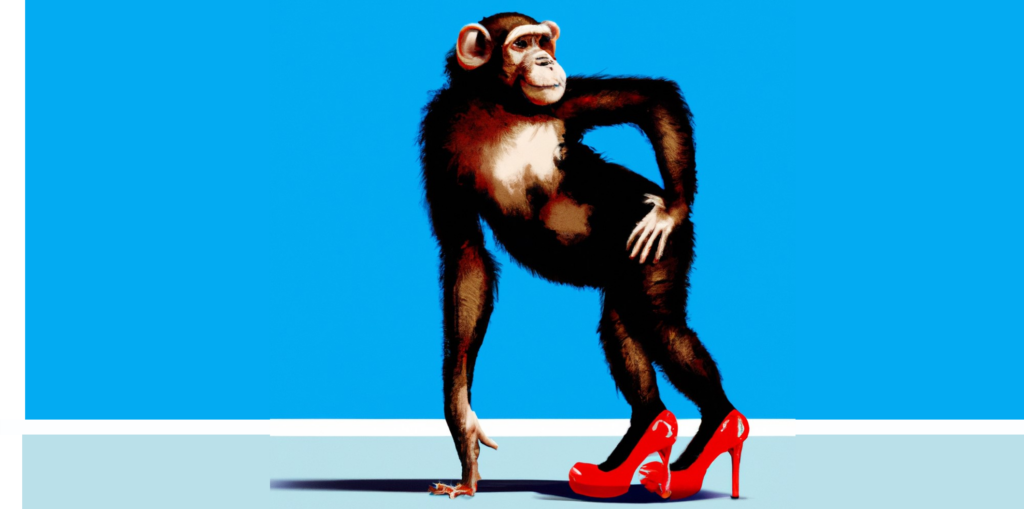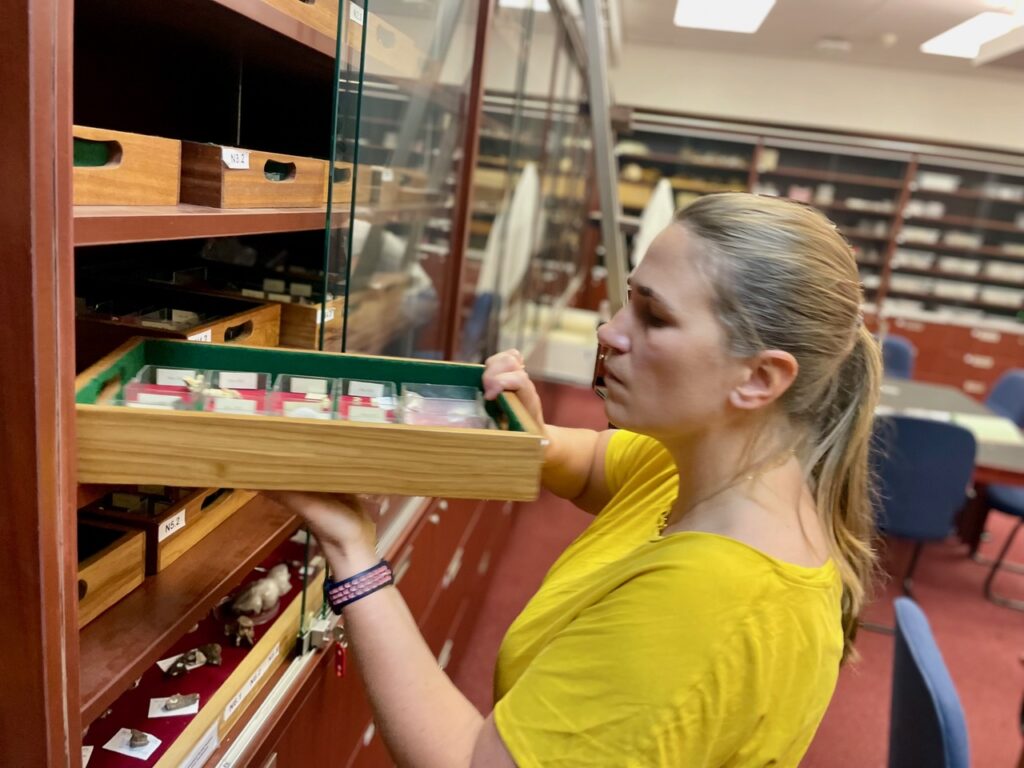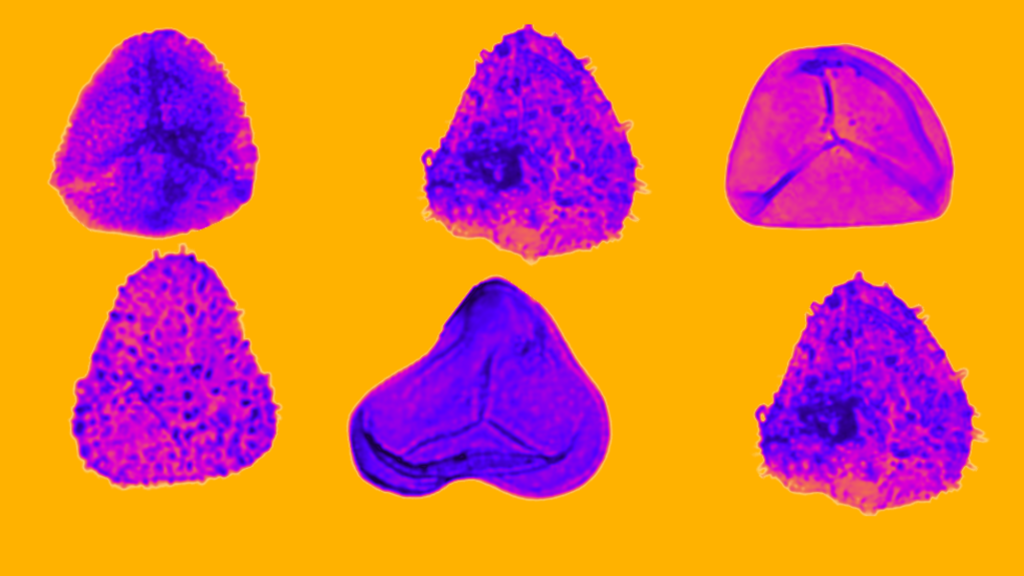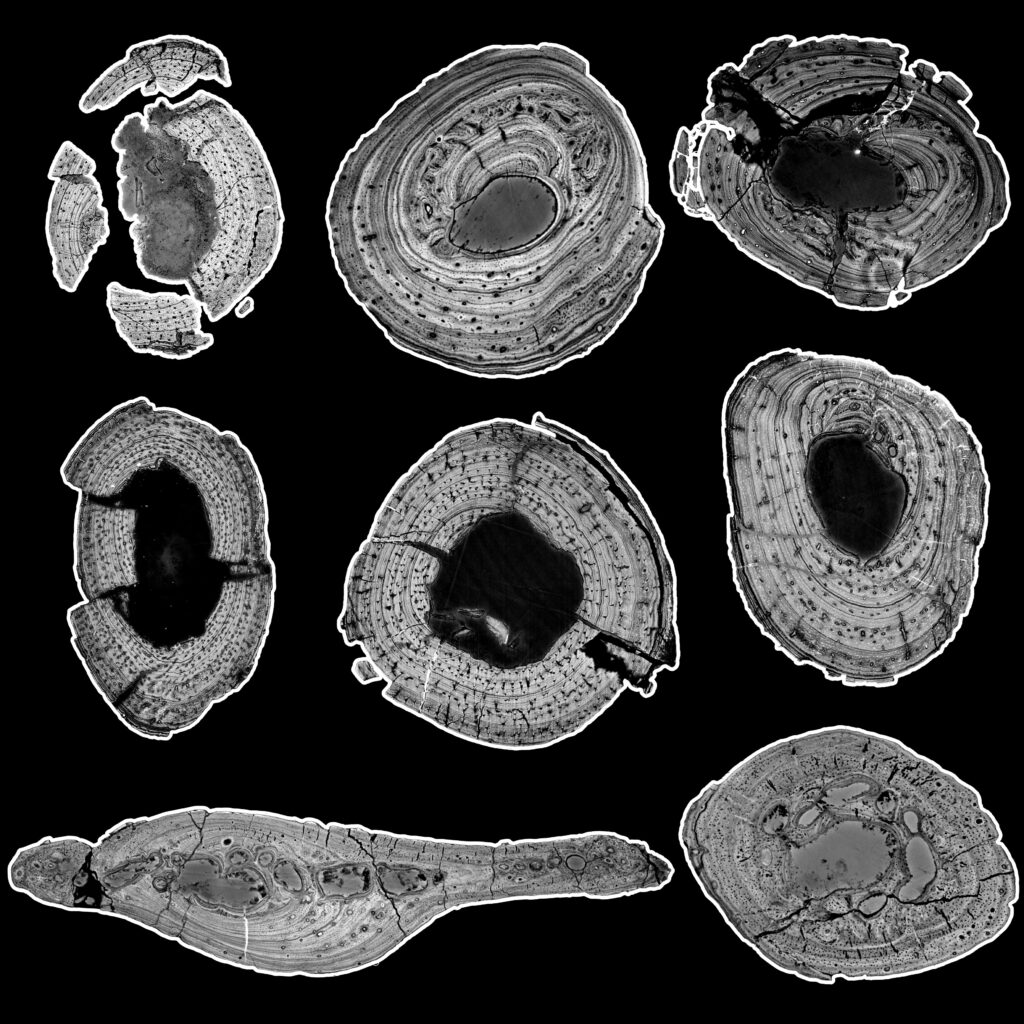The evolution of the human foot, and how our choice of footwear shapes our future

An impossible image of a chimpanzee wearing red high heels – it doesn’t have the feet for it! This image was created with the assistance of DALL·E 2
When we walk around, our feet are the first parts of our bodies to touch the ground. But other than choosing which shoes to go with our outfits, how many of us think about our feet and how they shape our daily lives? The human foot has experienced a remarkable transformation throughout human evolution, adapting to the diverse challenges presented by our changing environment. From the open savannah to the tarmacked street, our ancestors’ feet evolved in response to different evolutionary pressures, shaping how we walk, run, and interact with the world around us. What can our ancient past teach us about understanding the intricacies of our foot’s evolution? How can this help us unlock the key to understanding our footwear and how our feet are linked to our overall health and well-being?
Evolutionary Journey of the Human Foot:
To comprehend the significance of the human foot, we must embark on a journey through time, retracing the footsteps of our early ancestors. The story begins with Ardipithecus ramidus, an ancient hominin whose foot resembled that of great apes, like chimpanzees. Adapted for arboreal locomotion and grasping, its foot was broad, with curved toes, but lacked a well-developed longitudinal arch. Because of these characteristics, A. ramidus was adapted for life in the trees. It probably wasn’t a very elegant runner or walker.
As the era of bipedalism emerged, Australopithecus afarensis balanced between walking on two feet while retaining some toe-grasping abilities. While still displaying some features reminiscent of great apes, A. afarensis had a foot with certain characteristics more like modern humans. One significant change was that the entire foot contacted the ground during walking. This is evidenced by deep heel impressions in the footprints attributed to A. afarensis from 3.5 million years ago found in a fossilised riverbed at Laetoli, northern Tanzania. The adaptation helped increase the walking economy and reduce energy loss.

The Laetoli footprints, probably left by Australopithecus afarensis individuals some 3.5 million years ago, at Laetoli, northern Tanzania. Image from Encyclopaedia Britannica
This pivotal transitional stage led to the evolution of the modern human foot. One major change was the alignment of the big toe with the other toes, allowing for more effective push-off during walking and running. This alignment provides increased stability and propulsive power. The longitudinal arch of the foot also became higher and more developed in modern humans, enabling greater energy storage and release during running. Toes became shorter, and the midfoot region became more rigid, with a well-developed transverse arch contributing to foot stiffness and stability, making walking and long-distance running easier and more energy efficient.

The comparative anatomy of human and chimpanzee feet (as a proxy for Ardipithecus ramidus feet) – A. The presence of the longitudinal arch in human feet but lacking in chimpanzees. B. Human and chimpanzee foot biomechanics at bipedal walking push-off. Image from Asghar, A., & Naaz, S. (2022). The transverse arch in the human feet: A narrative review of its evolution, anatomy, biomechanics and clinical implications. Morphologie, 106: 225-234.
Since then, human feet have changed in several ways. Some of these changes are due to evolution, while others are due to changes in lifestyle and culture. The most notable changes have been in size, shape and flexibility. Our feet have become smaller and narrower, probably because we sit at desks more often than we walk or run outside. Most modern humans also tend to wear shoes habitually, restricting the movement of our feet, making them narrower and less flexible. Could shoes be linked to our foot’s evolution?

Nike Shoes on a black background, Pexels.
Putting Our Best Foot Forward – The Foot’s Influence on Modern Footwear
Our feet are complex structures. They contain almost one-quarter of all the body’s bones, 200,000 nerve endings, 26 bones, 30 joints, and more than 100 muscles, tendons, and ligaments. All these parts work together to allow us to walk, run, and jump. When we cover our feet with shoes, we are changing how we move. For example, shoes can change how our feet strike the ground, our muscles and joints work, and our bodies distribute weight.
In some cases, these changes can be beneficial. For example, shoes protect our feet from injury and provide support for weak or injured feet. However, in other cases, these changes can be harmful, and it could all depend on our choice of footwear.
Footwear emerged approximately 50,000 years ago, but the footwear we use today has evolved to be increasingly decorative or restrictive over the centuries. While cushioned footwear has grown in popularity, so too have high heels. High-heeled shoes are almost always narrow with tapering toe-boxes, which displace toes from their natural, broader position. Raising the heel from the natural position also forces the body to take on an increasingly unnatural posture to maintain its centre of gravity. These changes in foot posture can have significant effects on the feet as well as overall health, including increased pressure and discomfort, lower back pain, reduced stability, increased risk of foot and ankle injuries and long-term structural changes when high-heeled shoes are worn regularly.
The study of the foot’s evolution holds profound implications for the design and functionality of modern footwear. Researchers gain valuable insights into optimal shoe design by examining key features such as the longitudinal arch and the structure of our toes. The longitudinal arch, a defining characteristic of the human foot, acts as a natural shock absorber and lever during movement. Understanding its importance helped us create shoes that support or even enhance foot performance or alternatively, allow us to express ourselves through our footwear (even if it sacrifices comfort!).

People’s bare feet on a white floor, Pexels
The Toe Bone Is Connected to the Foot Bone – Foot Anatomy and Our Overall Health:
Have you ever thought about how important your feet are to your health? The human foot serves as the foundation for our entire body. Its complex mechanics impact posture, balance, and overall body alignment. Neglecting foot health can have a ripple effect, leading to issues in the knees, hips, spine and even the heart! Common foot ailments such as plantar fasciitis, bunions, and flat feet can be attributed to various factors, including poor footwear choices and modern lifestyle habits. Various systemic health conditions can manifest in the feet, such as diabetes and circulatory disorders. Monitoring foot health is particularly crucial for individuals with these conditions, as poor foot health can lead to serious complications. Understanding the link between foot anatomy and overall health empowers us to make informed decisions regarding footwear and foot care. Engaging in foot exercises, regular stretching, and wearing shoes promoting natural foot function is essential to maintaining foot health and preventing potential complications.
Similarly, our propensity for wearing cushioned footwear from a young age counteracts any potential evolutionary adaptations for barefoot walking. This disparity has sparked a growing public and scientific debate surrounding the benefits and drawbacks of walking barefoot, wearing traditional shoes, or opting for minimalist footwear. Various scientific studies have shown the benefits of barefoot walking for adults and toddlers, including Improved balance and coordination, stronger feet, improved circulation, increased sensory awareness and reduced stress.
Innovations in Footwear and Future Possibilities:
Walking barefoot, compared to wearing shoes, can significantly affect gait variability and standard gait parameters. Barefoot walking may reduce the risk of falling by decreasing midfoot-toe clearance (MTC) variability; It is an important parameter in gait analysis as it reflects the foot’s ability to clear obstacles and maintain stability during locomotion. This parameter is associated with the risk of tripping and falling. A higher MTC variability, meaning greater fluctuations in the clearance distance, is linked to an increased risk of falls.
Understanding the evolution, form and function of the foot and the rapid advancements in technology and materials have revolutionised the world of footwear. Cutting-edge innovations now offer a range of possibilities to enhance comfort, performance, and foot health. From responsive cushioning systems to breathable and lightweight fabrics, these developments prioritise function and style. Understanding the evolution of the foot has also played a crucial role in developing minimalist footwear. Researchers have gained insights into the ideal foot posture and mechanics for optimal function by studying the human foot’s natural design and movement patterns throughout evolution. This knowledge has been used to inform the design of minimalist shoes.
Minimalist footwear claims to mimic the barefoot experience by providing minimal interference with foot mechanics and a more natural foot shape. These shoes typically have a thin, flexible sole for better sensory feedback and a wider toe box that allows the toes to splay and engage the muscles more effectively. While some studies claim that wearing minimalist footwear has shown numerous advantages for foot health and overall well-being, others warn against it. The current debates about the pros and cons of minimalist footwear revolve around its potential benefits, risks, suitability for different individuals and activities, injury prevention, foot support and stability, performance and efficiency, individual variability, and the need for further research and evidence.
Regardless of our choice of footwear, as we reflect on the evolution of our feet, it is a gentle reminder to occasionally embrace our primal instincts and indulge in the simple pleasure of feeling the grass beneath our bare toes!

A Person Stepping on the Grass, Pexels
With thanks to Dr Bernhard Zipfel for his insightful inputs for this Aricle.
References
This article and video references the following scientific papers-
Asghar, A., & Naaz, S. (2022). The transverse arch in the human feet: A narrative review of its evolution, anatomy, biomechanics and clinical implications. Morphologie, 106(355), 225-234.
D’AoÛt, K., Pataky, T. C., De Clercq, D., & Aerts, P. (2009). The effects of habitual footwear use: foot shape and function in native barefoot walkers. Footwear Science, 1(2), 81-94.
DeSilva, J., McNutt, E., Benoit, J., & Zipfel, B. (2019). One small step: A review of Plio‐Pleistocene hominin foot evolution. American journal of physical anthropology, 168, 63-140.
Gimunová, M., Kolářová, K., Vodička, T., Bozděch, M., & Zvonař, M. (2022). How barefoot and conventional shoes affect the foot and gait characteristics in toddlers. Plos one, 17(8), e0273388.
Hollander, K., Petersen, E., Zech, A., & Hamacher, D. (2022). Effects of barefoot vs. shod walking during indoor and outdoor conditions in younger and older adults. Gait & Posture, 95, 284-291.
Holowka, N. B., & Lieberman, D. E. (2018). Rethinking the evolution of the human foot: insights from experimental research. Journal of experimental biology, 221(17), jeb174425.
McNutt, E. J., Zipfel, B., & DeSilva, J. M. (2018). The evolution of the human foot. Evolutionary Anthropology: Issues, News, and Reviews, 27(5), 197-217.





